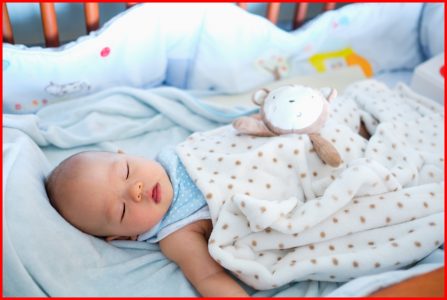Safe Sleep and Your Baby
Updated May 13th, 2024

Why baby’s sleep space is important
Parents are often surprised to learn that 1-2 infants die unexpectedly in their sleep every month in Manitoba. This can be due to suffocation, Sudden Infant Death Syndrome (SIDS) or other causes. The best prevention is to provide a safe sleep space for your baby for every sleep and nap.
Check out this video for simple safe sleep tips!
Note: Other videos may be recommended by the host channel (e.g. YouTube, Vimeo). These suggestions may be based on your personal search history and other factors. The WRHA does not control these suggestions and is not responsible for and may not endorse the content.
Follow these tips for every sleep until your baby is one year of age
1. Choose a safe sleep space
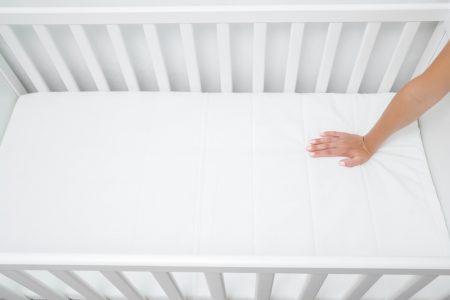 Choose a crib, cradle or bassinette that meets Canadian safety regulations. The mattress should be the right size, firm, clean and flat. See Health Canada’s Is Your Child Safe? Sleep Time.
Choose a crib, cradle or bassinette that meets Canadian safety regulations. The mattress should be the right size, firm, clean and flat. See Health Canada’s Is Your Child Safe? Sleep Time.
The crib, cradle or bassinet should meet Health Canada standards.
The mattress must be:
• Firm
• Flat
• The right size for crib, cradle or bassinet
NO
• Pillows or bumper pads
• Bottles
• Stuffed animals, toys
• Sleep postioners
• Loose blankets or quilts
• Nothing around baby’s neck such as jewelry, teething necklaces, bibs or soother strings
2. Place crib in your room
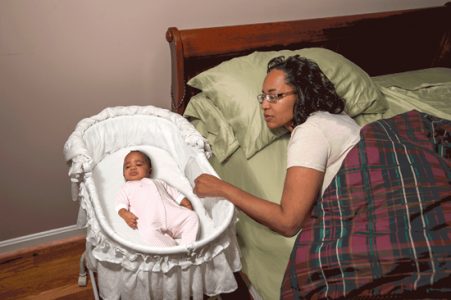 Safest place for a baby to sleep is in a crib, cradle or bassinet in your room for the first six months, or ideally, for the first year.
Safest place for a baby to sleep is in a crib, cradle or bassinet in your room for the first six months, or ideally, for the first year.
Sharing a bed with your baby (often called bed-sharing or co-bedding) is not recommended as it puts the child at risk of suffocation, SIDS, strangulation and falls. For information on safer bed-sharing, click here.
3. Place baby on back for sleep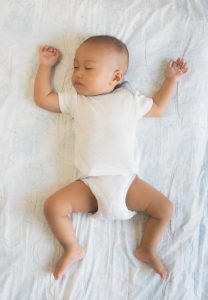
Infants that sleep on their back are less likely to choke or suffocate than tummy or side sleeping infants.
- no sleeping on tummy
- no sleeping on side
4. Avoid overheating
 Choose one piece sleepers that are the right thickness for the room temperature.
Choose one piece sleepers that are the right thickness for the room temperature.
- If you find the room temperature comfortable, your baby will too.
- Avoid extra blankets as they can cause overheating and suffocation.
- If using a sleep sack, choose one with fitted neck and armholes and no hood.
- If using a blanket,
- look for one made of light breathable fabric
- place baby in crib with feet at bottom of crib
- tuck blankets under baby’s armpits and tuck in firmly on both sides and at bottom end of crib.
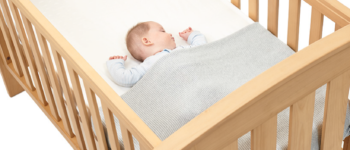
- Hats can make most babies too hot
- See Safer Swaddling Tips
5. Breastfeeding Protects Baby
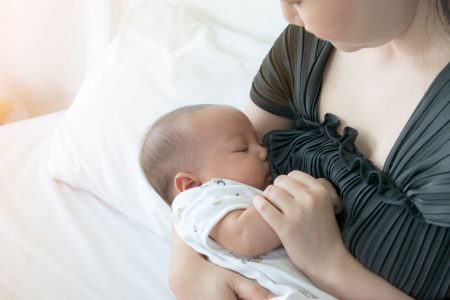
Breastfeeding lowers the risk of Sudden Infant Death Syndrome (SIDS).
- Any amount of breastfeeding can help protect your baby from SIDS. Breastfeeding exclusively for the first 6 months can lower the risk of SIDS by up to 50%.
- After feeding, return baby to crib, cradle or bassinet for sleep.
- Once breastfeeding is established, consider using a pacifier, which may reduce the risk of SIDS.
If you bottle-feed your baby, always hold baby to feed. Don’t bottle-prop. You can still protect your baby by following the rest of these tips.
6. Keep Baby Smoke-free Before and After Birth
 This is one of the most important things you can do to reduce the risk of SIDS. Smoking is responsible for one in three SIDS deaths.
This is one of the most important things you can do to reduce the risk of SIDS. Smoking is responsible for one in three SIDS deaths.
-
Avoid smoking and vaping during pregnancy.
- It is best to keep your home or anywhere your baby sleeps or spends time smoke-free and vape-free. Exposure to smoking in early infancy increases the risk of SIDS
- The risk of SIDS increases when the mother smokes; this is even higher when the father also smokes.
- SIDS risk increases with:
- the number of smokers in the home
- the number smokers in the same room as the baby
- the number of cigarettes smoked
- and daily hours the baby is exposed to smoke.
- No smoking at all is best for you and your baby, but lowering the amount of cigarettes you smoke can lower the risk.
- If you smoke, it is best to do it outside, and then change your clothes and wash your hands before handling your baby.
- In Manitoba it is illegal to smoke in a car when children under 16 are present.
- Are you thinking about quitting smoking? Talk to your health care provider or contact Smokers’ Helpline (phone 1-877-513-5333)
- Also see Tobacco: Know the facts
Other Safe Sleep Options
The safest place for a baby to sleep is in a crib, cradle or bassinet. Bassinets that are sold with some playpens are a lower cost choice. Parents may use other options for a temporary baby bed. Talk to your public health nurse to make sure it is as safe as possible. The surface baby sleeps on should be firm, flat, fit snugly, and only needs a thin cover. You can use a light blanket wrapped around and taped to a sturdy piece of cardboard for a mattress. Never use pillows
or soft bedding
All sleep spaces should be kept:
• On the floor
• Away from baseboard or portable heaters, fireplaces, wood stoves, ovens and other sources of heat
• Away from pets

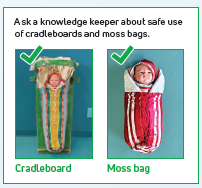
Unsafe Sleep Spaces
Images with a X are not safe sleep spaces. Sharing any sleep surface with your baby is unsafe.

References/Resources:
Safe Sleeping for Your Baby, Government of Manitoba
Safe Sleep for Your Baby, Public Health Agency of Canada
SIDS and Other Sleep-Related Infant Deaths: Updated 2016 Recommendations for a Safe Infant Sleeping Environment
American Academy of Pediatrics (AAP) How to keep your sleeping baby safe: AAP Policy Explained
Joint Statement on Safe Sleep: Reducing Sudden Infant Deaths in Canada
SAFE AND SOUND: A Special Report on the Unexpected Sleep-Related Deaths of 145 Manitoba Infants
